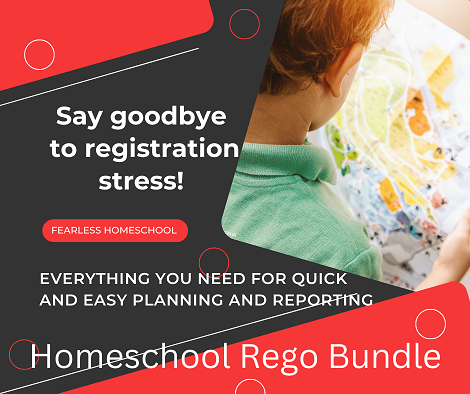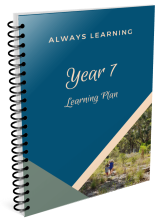|
Kindergarten Homeschooling
by Beverley Paine, 2021
You don't have to register your child for homeschooling until they reach compulsory school age (which is slightly different in each state so look up the Education Act, links in the Resource Directory).
Until then though there are lots of ways you can help you child learn. Setting up a learning environment isn't difficult, can be fun and produces a natural transition into a home educating lifestyle.
My house kind of looked like a kindy when my grandkids were younger... and that echoed how it looked when my kids were that age too and we were beginning to homeschool.
I preferred open shelves to cupboards and drawers as it made it easier for the kidlets to find what they wanted and to be be able to put it back where it belonged. I tried to not crowd the shelves with stuff. It's a good idea to rotate what is on the shelves - perhaps using a storage cupboard in another room.
We bought a child's paint easel/blackboard and primary washable paints, big tub of colourful crayola chalk (which we also used on the pavers outside).
We had a nature table and shelf where we put things we'd find on our walks and in the garden. We also had some A4 diaries and decorated the covers and used them for nature sketching.
Robin made a small workbench and added a vice which made it easier to hold wood while the kidlets worked. We bought a child's toy tool kit as it was hard to find small sized tools. Underneath the bench we had a crate of different sized pieces of wood, small rounds for wheels, cork coasters and mats, etc.
A whiteboard and pens inside on the wall encourage the kids to practice writing and drawing. I needed to chase the kids to remember to put the lids on the pens all the time but loved the way they used the whiteboard.
We had a tray with tins of pencils, crayons, scissors, rulers, stapler, sticky tape, masking tape, glue stick, glue gun, etc. The tray meant we could move the whole lot to our dining table, which is where most of the art and craft activity happened.
A huge box of recycled materials, mostly grocery packaging, was the source of most of the crafty happenings. I added anything that looked useful and fun during sales - pom poms, feathers, pop sticks, match sticks, raffia, wool, felt, material scraps, craft kits, etc. These I organised in separate containers, again easy to see and reach and put back.
We had a shelf of puzzles and another of board, card and dice games.
I'd kept all our kids Duplo, LEGO and Brio (wooden train set) and these lived in the same plastic crates we'd bought when our kids were little.
A favourite game was 'shops'. We had a small trolley that was permanently set up with a set of shelves made from cereal boxes held together with colourful book covering. An Ikea cash register and plastic money and recycled gift bags as shopping bags were well used. We take turns going shopping with the baby doll, usually buying Xmas gifts or birthday presents for baby doll's friends or being the shop keeper, whose job it was to write price labels and make sure the shelf was stocked, usually with items made during art and craft activities, felt fruit and vegetables.
I recycled a shoe box into a post box. The kids enjoyed writing and posting letters. I kept birthday and Xmas cards which they'd write on and post. A box of stickers they can draw on makes great stamps.
We also had a box of dress ups, including a doctor's kit. The best one we found for the grandkids was a vet kit from the zoo with added bandages. The dress ups included pieces of crushed velvet material I bought from Spotlight - cheetah, tiger, black, purple and red, as well as various scarfs, bought costumes.
Our living room still houses a collection of animal stuffed toys in a couple of cane baskets. There were usually two main games - zoos and vets.
We had a swing and slide outside, trampoline and sand pit. For the grandkids we've added a flying fox and monkey bars. A dirt pit somewhere is useful too, sand is great but it's not dirt. Buy extra garden trowels, they're just the right size, and maybe find some small rock picks for small hands. And something I've learned as a grandma, liberate some of the inside toys. In a year or two the kids won't want to play with them anymore and they won't really be good enough condition to pass on to op shops, so why not let a few live outside with the mud kitchen.
Mud kitchens are fun and don't have to be elaborate. Kids love picking leaves and flowers, mixing them with water, dirt and sand in old cooking pots, making and offering you pretend dinners and teas. I remember playing that game up until about age 9 as a child myself.
We found a display bookshelf which the kids really appreciated and regularly rotated books from our collection of picture books, including old favourites from our early years of homeschooling.
Writing was mostly me scribing on their artwork describing what it was, or their stories. For the grandkids I like to type stories they tell me and they like to find pictures online as illustrations. We also had sets of magnetic and plastic letters and played our own versions of Scrabble and Upwords.
For maths I invested in a class set of wooden base ten blocks, Cuisenaire blocks, and MUS integer blocks. We mainly use these for play but I added a set of number cards (Montessori style) for structured play (usually with the Brio or small cars). We also had a 100 number board with tiles left over from homeschooling our kids that has been used a few times with the grandkids. We bought the grandkids SchoolZone workbooks when they want to play doing real 'school'.

Was this article helpful? Was it worth $1.00 to you?
Your gift of $1 or more helps to keep this site operating
offering encouragement
and reassurance to families
wanting
better outcomes for their children.



Beverley Paine with her children, and their home educated children, relaxing at home.
Together with the support of my family, my aim is to help parents educate their children in stress-free, nurturing environments. In addition to building and maintaing this website, I continue to create and manage local and national home educating networks, help to organise conferences and camps, as well as write for, edit and produce newsletters, resource directories and magazines. I am an active supporter of national, state, regional and local home education groups.
"You've been an inspiration to me, I love the way
you really listen to people." Vanessa
"Whenever I read your writing I always come away
with increased confidence in my ability to provide and
share a wonderful learning journey with my family!" Davina
"Your guidance, understanding, support and words of
wisdom changed our lives. We now offer support and
organise many homeschooling events for others." Lesley
"Thank you once again for your prompt and friendly service.
I am convinced that your books are going to add
quality and peace of mind to my journey of teaching my kids
at home! Just from studying your website, until almost
2am
in the morning, I 've been encouraged!" Louisa
"Thank you for all your many,many reassuring words
over many, many years. You probably don't know exactly how
valuable you are to the Australian Home Education community.
I've been reading your stuff for maybe 8 years or more now.
And I'm very grateful." Gythaa


Want to learn how to write your own education plans
to suit your unique children's individual learning needs?
Or you are looking for quality curriculum and teaching tips...
Comprehensive 3 workbook 'how to home ed' course
covering the essential skills you need
successfully home educate your children

|
|
Welcome to the World of Home Education
and Learning without School!
We began educating our children in 1985, when our eldest was five. In truth, we had helped them learn what they need to learn since they were born. I am a passionate advocate of allowing children to learn unhindered by unnecessary stress and competition, meeting developmental needs in ways that suit their individual learning styles and preferences. Ours was a homeschooling, unschooling and natural learning family! There are hundreds of articles on this site to help you build confidence as a home educating family. We hope that your home educating adventure is as satisfying as ours was! Beverley Paine
3 ESSENTIAL STEP BY STEP GUIDES
Let experienced home educators Beverley, Tamara and April walk you through HOW to create a learning plan that builds on solid foundations that works for YOUR family AND ticks all the boxes for home educaton registration!
|

Tap into Beverley's
experience
through her books
"Your books, your blogs helped me beyond words... they helped me to find comfort in knowing it is ok to choose exactly what is best for my family." Nisha
"Your books and information are mind blowing and already I am feeling good about this new experience." Diane
"Your guidance, understanding, support & words of wisdom changed our lives." Leslie
"I feel specially inspired by Beverley's words and, the more I read her comments, the more inspired I feel, since my need for support, respect for different parenting styles, and information are fully met." Marijo
|
 |
|



The information on this website is of a general nature only and is not intended as personal or professional advice. This site merges and incorporates 'Homeschool Australia' and 'Unschool Australia'.
The Educating Parent acknowledges the Traditional Aboriginal and Torres Strait Islander Owners, the Custodians of Australia, and pay our respects to Elders past and present and extend that respect to Aboriginal and Torres Strait Islander people viewing this website.

Advertise on this site.








Home education is a legal alternative
to school education in Australia.
State and Territory governments are responsible
for regulating home education and have different
requirements, however home educating families
are able to develop curriculum and learning programs
to suit the individual needs of their children.

Without revenue from advertising
by educational suppliers and Google Ads
we could not continue to provide information
to home educators. Please support us by letting
our advertisers know that you found them on
The Educating Parent. Thanks!
|
![]() About
About
![]() Blog
Blog
![]() Articles
Articles
![]() Curriculum
Curriculum
![]() Resource Directory
Resource Directory
![]() Shop
Shop
![]() Facebook
Facebook

![]() SA
SA ![]() VIC
VIC ![]() NSW
NSW ![]() QLD
QLD ![]() TAS
TAS ![]() ACT
ACT ![]() NT
NT ![]() NSW
NSW ![]() QLD
QLD ![]() SA
SA ![]() WA
WA ![]() TAS
TAS ![]() ACT
ACT ![]() NT
NT 















